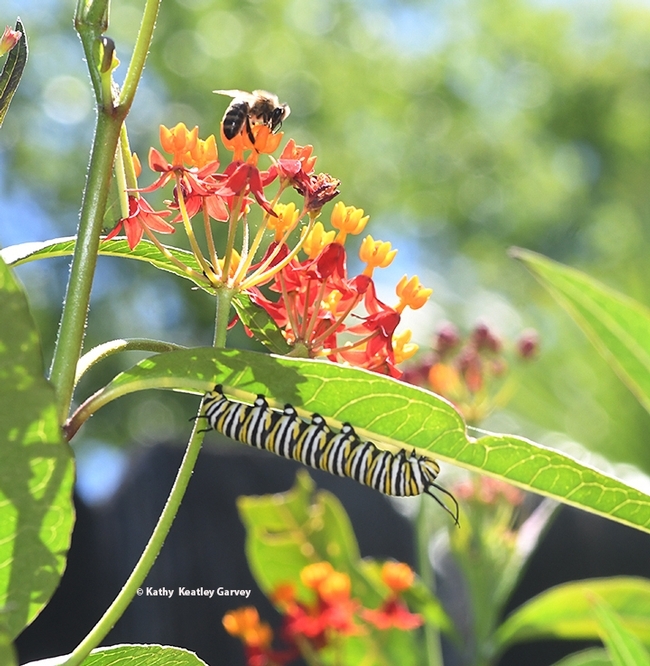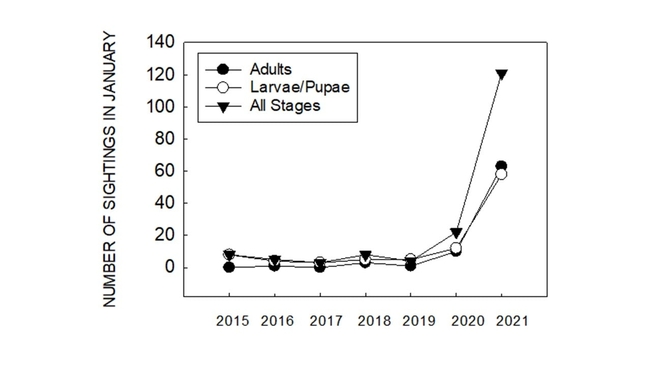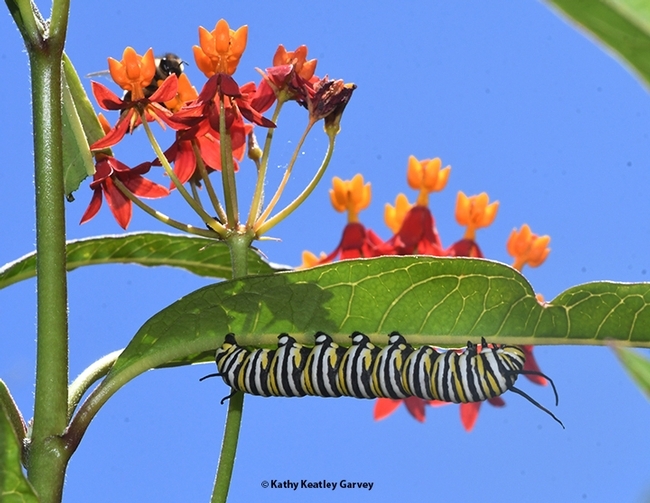
Butterfly guru Art Shapiro, UC Davis distinguished professor of evolution and ecology, spotted a female monarch butterfly at 1:35 today.
As he mentioned in his email: "So, at 1:25 p.m. a female monarch flew directly over my head, roughly 8' off the ground, near the corner of Oak Avenue and 8th Street. It was headed northeast very lazily."
Shapiro noted that Kathy Keatley Garvey saw a monarch in Benicia on Jan. 23, "so this is the second sighting known to me this year in this general area. If there are really only 3000 or fewer overwintered in the whole state, I guess we won the lottery!"
So, the count as we know it:
- Monarch butterfly, gender unknown, flying over 115 West G St, Benicia, on Feb. 23, Garvey sighting
- Monarch butterfly, a male, that the Garveys reared in west Vacaville and released on Feb. 25
- Monarch butterfly, a female, flying near the corner of Oak Avenue and 8th Street, Davis, on March 2, Shapiro sighting
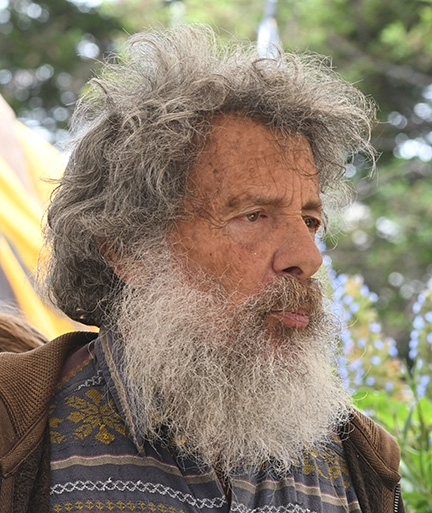
Now some folks are blaming tropical milkweed, Asclepias curassavica, a non-native, as a serious threat in the massive decline of the monarch population.
Don't blame tropical milkweed, agree Shapiro and monarch researcher David James, an entomologist and associate professor at Washington State University (WSU).
James told us in an email: "I have been involved with monarchs for 43 years, and the single, overriding thing that I have learned is that the monarch is a highly adaptable creature! It has an incredible ability to adjust to changing environmental circumstances. In Australia, it took less than 100 years to change its core physiology as part of adaptation to a different climate. Adapting to man-made environmental challenges may take monarchs a while but I believe it can happen."
"I believe that the widespread and intensive use of neonicotinoid insecticides is one likely factor behind the current monarch population decline," James says. "But even with insecticides, insects can develop resistance over generations. The few monarchs that are alive and well in California currently are the survivors, those that have beaten the perils stacked against them. Clearly, we need to try and make life as fruitful as possible for these survivors, to aid in their population recovery. These monarchs will produce progeny that are also ‘fitter' than the general population and we need to ensure that milkweed is there for them, particularly during spring in California."

"The monarch as a species is particularly good at trying different things," James points out. "Thus, while the majority of the population does one thing (like migrate and overwinter), there is always a significant subset exposed to the same environment, that decides to do something different, like not migrate. Most of these of course will die but in some circumstances, some locations, the outcome may be good, giving another option for continuation of the species, should it become necessary. We may be seeing this now with the rise in winter breeding of monarchs in warmer parts of interior California like the LA Basin and SF Bay Area. There is also evidence for the first time of breeding winter monarch survival in far southwestern Oregon."
A post on texasbutterflyranch.com touched on the native/non-native milkweed controversy. "David James takes issue with the loud and persistent claim that non-native milkweeds pose serious threats to monarch butterflies and the viability of their migrations. When asked if he thinks the technically non-native tropical milkweed poses a dire threat to monarch butterflies, James' answer was emphatic."
No, he does not. "Not at all, in fact," he told them.
You can follow David James' research and observations on his group's Facebook page, Monarchs of the Pacific Northwest at https://www.facebook.com/MonarchButterfliesInThePacificNorthwest.
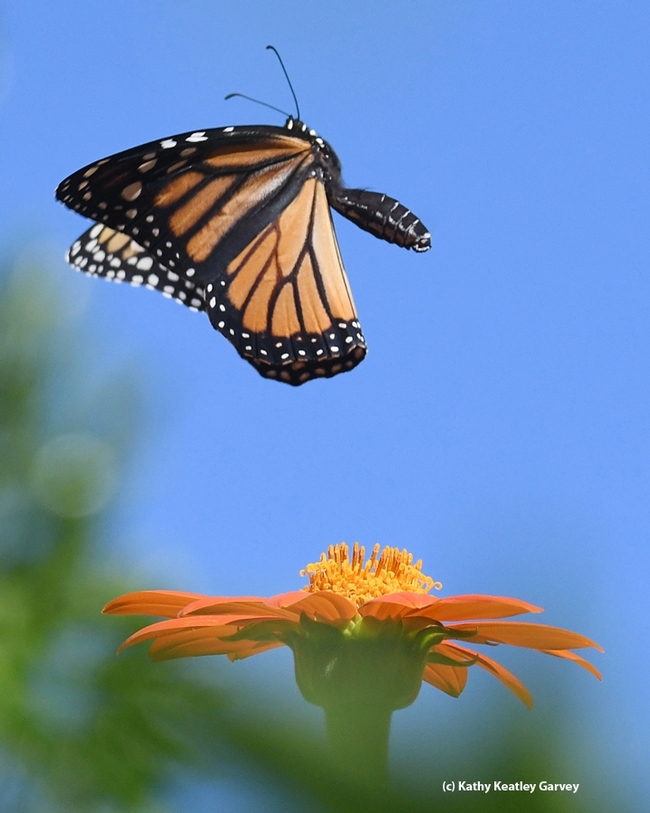
On Jan. 12 James posted a graph showing "the number of observations of monarch larvae/pupae (as recorded on I-Naturalist) in the San Francisco Bay area during November/December for every year since 2015. The graph showed a huge (>5X) increase in observations in 2020 compared to each of the the previous 6 years. I have now extracted data on monarch reports for January 2021 and compared them to the previous six years (see graph below). Once again, the data show a large increase in reports of both adult and immature stage monarchs during the past month in the SF Bay area. In fact, the increase is greater than for Nov-Dec. The average number of larvae/pupae reported on I-Nat during January from 2015-2019 was 1.0. This year the number was 63. Similarly an average of 5.0 adults were reported for January during 2015-19, yet this year there were 58 sightings reported to I-Nat. Of course some of this increase can be explained by increased use of I-Nat in these covid times to report sightings, but I doubt that this explains it all. Interestingly, there were signs last January of an increase in sightings when 10 larvae and 12 adults were reported. But the numbers in January 2021 are on another level."
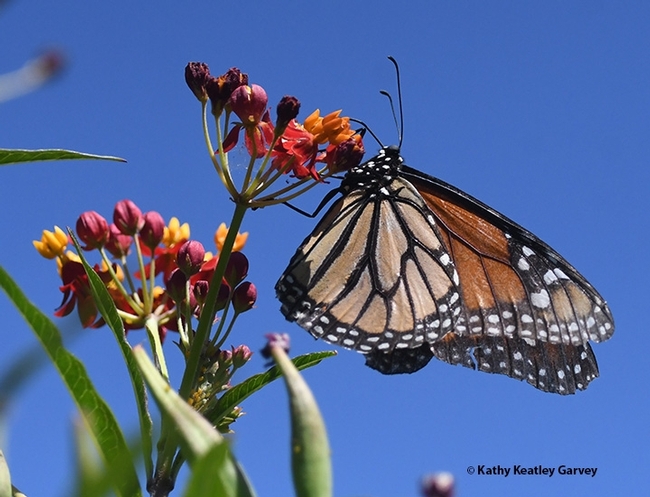
James' work draws such comments as "You rock, Dr. David James! Thank you for speaking common sense and not regurgitating a hard line which equates to death for the monarchs when milkweed is purposely cut and no milkweed is available for the next generation to consume! I look forward to more findings from you and your honest research reporting. Thank you so much for all you do to help the monarchs thrive not just survive!"
Meanwhile, anyone else see any monarchs flying around the Bay Area and/or in Yolo and Solano counties?
Attached Images:
